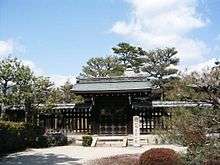Emperor Kameyama
| Kameyama | |
|---|---|
| Emperor of Japan | |
 Kameyama | |
| Reign | 1259–1274 |
| Predecessor | Go-Fukakusa |
| Successor | Go-Uda |
| Born | July 9, 1249 |
| Died | October 4, 1305 (aged 56) |
| Spouse | Fujiwara no Saneko, Fujiwara no Kishi |
Emperor Kameyama (亀山天皇 Kameyama-tennō) (July 9, 1249 – October 4, 1305) was the 90th emperor of Japan, according to the traditional order of succession. His reign spanned the years from 1259 through 1274.[1]
Genealogy
Before his ascension to the Chrysanthemum Throne, his personal name (his imina) was Tsunehito-shinnō (恒仁親王).[2]
He was the 7th son of Emperor Go-Saga
- Empress (Kōgō) Tōin (Fujiwara) Fujiwara no Saneko (洞院(藤原)佶子)
- First daughter: Imperial Princess ?? (目見子内親王)
- First son: Imperial Prince ?? (知仁親王)
- Second son: Imperial Prince Yohito (世仁親王) (Emperor Go-Uda)
- Empress (Chūgū – a lower rank than Kōgō) Saionji (Fujiwara) Yoshiko (西園寺(藤原)嬉子)
- Court Lady: Konoe (Fujiwara) ?? (近衛(藤原)位子)
- Eighth son: Imperial Prince ?? (啓仁親王)
- Tenth son: Imperial Prince ?? (継仁親王)
- Lady-in-waiting: Eldest daughter of Sanjō (Fujiwara) ?? (三条(藤原)実平)
- Fourth son: Prince Ryōsuke? (良助法親王) (Buddhist Priest)
- Sixth son: Prince Shōun? (聖雲法親王) (Buddhist Priest)
- Seventh son: Prince ?? (覚雲法親王) (Buddhist Priest)
- Fifth daughter: Wife of Kujō ?? (九条師教)
- Lady-in-waiting: Fujiwara ?? (藤原雅子)
- Second daughter: Imperial Princess ?? (憙子内親王) – Empress Dowager ?? (昭慶門院)
- Lady in waiting: Daughter of ?? (平時仲)
- Ninth son: Prince ?? (順助法親王) (Buddhist Priest)
- Eleventh son: Prince ?? (慈道法親王) (Buddhist Priest)
- Twentieth (twelfth?) son: Prince Gyōen (行円法親王) (Buddhist Priest)
Other names Emperor Kameyama had were:
- ?? (金剛源) – his name as a monk
- Zenrinji-dono (禅林寺殿) – Literally "Lord Zen-Temple" From the fact that he had a Zen temple in the north wing of his Imperial Villa
- Madenokō-ji-dono (from his residence)
- Bun'ō Kōtei (From the era name; Kōtei is another word for Emperor)
The name Kameyama comes from the location of his tomb.
Events of Kameyama's life
In 1258, he became Crown Prince at age 9.
- 1259 (Shōgen 1, 11th month): In the 14th year of Go-Fukakusa-tennō 's reign (後深草天皇十四年), the emperor abdicated; and the succession (‘‘senso’’) was received by his younger brother. Shortly thereafter, Emperor Kameyama is said to have acceded to the throne (‘‘sokui’’).[3]

In 1263, during the Kamakura Rebellion, the 6th Shōgun, Imperial Prince Munetaka (eldest son of Emperor Go-Saga) was recalled from Kamakura to be replaced by his son Imperial Prince Koreyasu (age 2).
In 1265 a Mongol delegation arrived from Kublai Khan, ruler of the Mongol Empire. On its way to Japan, they looted islands. The Mongols invited Japan to submit to the rule of Kublai. The Emperor and the Imperial Court suggested compromise,[4] but they were ignored by the shogun in Kamakura. The Mogolian delegation was sent back.
In 1274, abdicating to his son, Emperor Go-Uda, he began his reign as cloistered emperor.
During his time as cloistered emperor, the Mongols invaded the second time. Kameyama personally prayed at the Grand Shrine of Ise. On August 15, 1281, Kameyama-Jokō asked for Amaterasu intervention on behalf of Japan.
However, the Bakufu watched Kameyama with suspicion, and in 1287, encouraged Emperor Go-Uda to abdicate, and pushed for the enthronement of Emperor Go-Fukakusa's son, who became Emperor Fushimi. Kameyama's cloistered rule was suspended by this.
Later, Imperial Prince Hisa'aki, Emperor Go-Fukakusa's son, became Shōgun strengthening the position of the Jimyōin-tō. This caused Kameyama to become despondent, and in 1289 he entered the priesthood, joining the Zen sect. Because of this, Zen Buddhism slowly penetrated into the Court Nobility.
In 1291, he helped establish the Buddhist temple Nanzen-ji in Kyōto.

In 1305, he died. Emperor Kameyama is enshrined at Kameyama no Misasagi in Kyoto; and this Imperial mausoleum is maintained by the Imperial Household.[5]
Kugyō
Kugyō (公卿) is a collective term for the very few most powerful men attached to the court of the Emperor of Japan in pre-Meiji eras. Even during those years in which the court's actual influence outside the palace walls was minimal, the hierarchic organization persisted.
In general, this elite group included only three to four men at a time. These were hereditary courtiers whose experience and background would have brought them to the pinnacle of a life's career. During Kameyama's reign, this apex of the Daijō-kan included:
- Kampaku, Takatsukasa Kanehira, 1254–1261
- Kampaku, Nijō Yoshizane, 1261–1265
- Kampaku, Ichijō Sanetsune, 1265–1267
- Kampaku, Konoe Motohira, 1267–1268
- Kampaku, Takatsukasa Mototada, 1268–1273
- Kampaku, Kujō Tadaie, 1273–1274
- Sadaijin
- Udaijin
- Nadaijin
- Dainagon
Eras of Kameyama's reign
The years of Kameyama's reign are more specifically identified by more than one era name or nengō.[6]
See also
Notes

- ↑ Titsingh, Isaac. (1834). Annales des empereurs du Japon, pp. 255–261; Varley, H. Paul. (1980). Jinnō Shōtōki. pp. 232–233.
- ↑ Titsingh, p. 255; Varley, p. 232.
- ↑ Titsingh, p. 265; Varley, p. 44; a distinct act of senso is unrecognized prior to Emperor Tenji; and all sovereigns except Jitō, Yōzei, Go-Toba, and Fushimi have senso and sokui in the same year until the reign of Emperor Go-Murakami.
- ↑ Smith, Bradley Japan: A History in Art 1979 p.107
- ↑ Ponsonby-Fane, Richard. (1959). The Imperial House of Japan, p. 422.
- ↑ Titsingh, p. 255.
References
- Ponsonby-Fane, Richard Arthur Brabazon. (1959). The Imperial House of Japan. Kyoto: Ponsonby Memorial Society. OCLC 194887
- Titsingh, Isaac. (1834). Nihon Odai Ichiran; ou, Annales des empereurs du Japon. Paris: Royal Asiatic Society, Oriental Translation Fund of Great Britain and Ireland. OCLC 5850691
- Varley, H. Paul (1980). Jinnō Shōtōki: A Chronicle of Gods and Sovereigns. New York: Columbia University Press. ISBN 978-0-231-04940-5. OCLC 914584.
| Regnal titles | ||
|---|---|---|
| Preceded by Emperor Go-Fukakusa |
Emperor of Japan: Kameyama 1260–1274 |
Succeeded by Emperor Go-Uda |
